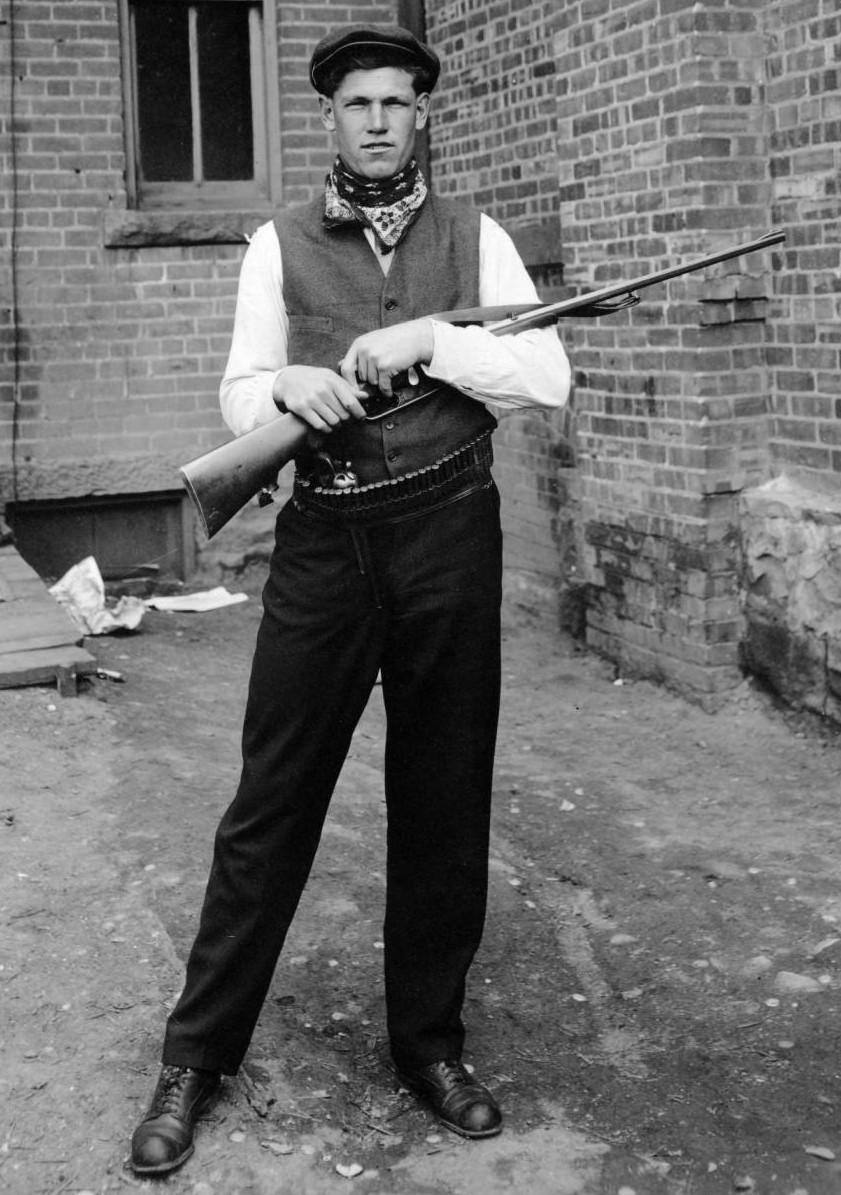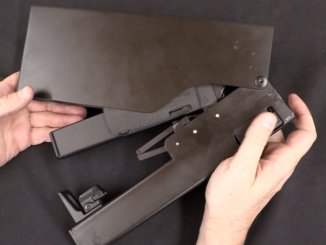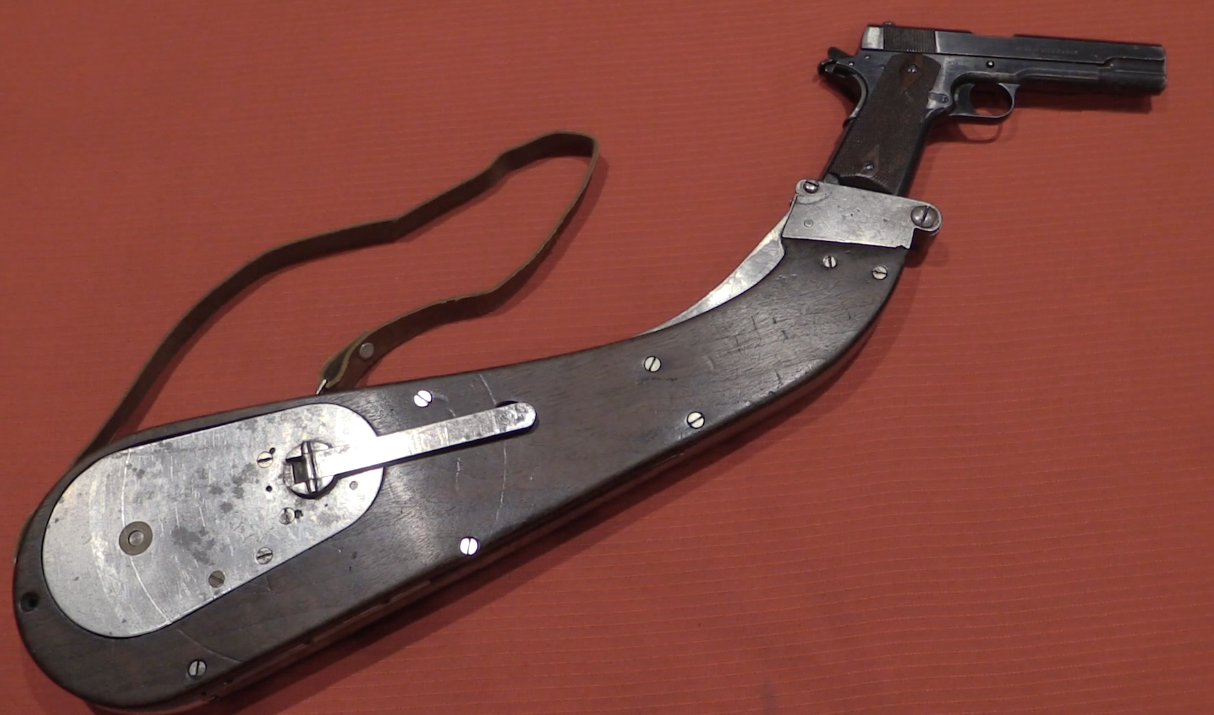The Cameron-Yaggi conversion was an experimental American trench rifle that was never put into service. However, this one example has survived, and today we are going to put a few rounds through it.
The literature says that recoil is mild, and the periscope actually moves away form the shooter when fired. This is not the case. The periscope goes right back into the shooter’s eye, because it has a very short eye relief. The periscope also provides a very narrow field of view, and I expect it would have been very difficult to actually use this contraption effectively in the fighting of World War One. That said, the device is sturdy and easy to use, unlike most of the other trench rifle adaptations I have seen.




Smart device, but practicality… meh, appears to be questionable. Is it possible that enemy would spot ‘hopping rifle’ ahead and focus on it? In other words, is there a net gain?
We must appreciate Ian’s inventiveness when comes to fixing the setup and sacrifice in damaged glasses. I give him ‘one’ with asterisk. 🙂
If the other team spots the periscope rifle, there’s very little that can be accomplished without requesting a heavy field gun or a mortar to fire a minimum of 50 shells on that one spot just to make sure that the periscope sniper is dead beyond any form of resuscitation! “Stupid camping periscope guys always seem to come back with vengeance just after you shoot their beloved toys to hell. Next week they’ll have ten rigged rifles and a machine gun per man operated by wires and tubes and aimed with mirrors! And then we’ll be hamburger! That’s just not fair!”
🙂
Today it is bit easier, we have fiber-optics. Oh yeah and I forgot…. observation drones. Enemy has no chance…. but wait a second: is the enemy so dumb?
If you assume enemy infantry are really far away from their artillery, there is little that they can use other than hand grenades to combat periscope rifles, which requires getting very close to your trench. After all, machine gun fire from half a kilometer away won’t work on a periscope very well. Thinking in the terms of the Great War, most officers (hopefully this is actually wrong) considered periscope weapons the marks of cowards. “A man who cannot stand up and fight properly is a disgrace to his country. I don’t care if the other team has a thousand of those fancy toys! Kill them all!!”
“fiber”
Do you mean Голодяев device?
photo http://otvaga2004.ru/wp-content/uploads/2014/05/otvaga2004_za-ugol_05.jpg
from http://otvaga2004.ru/armiya-i-vpk/armiya-i-vpk-concept/iz-okopa-iz-za-ugla-iz-tanka/
tested in 1995?
Data and more photos of Голодяев devices
http://otvaga2004.ru/kaleydoskop/kaleydoskop-inf/dlya-strelby-za-ugol/
1st photo from top explaining idea of this, image-capturing-part and image-showing-part can move thanks to fiber connection.
Yeah, that’s the idea. If you have properly quipped goggles with fibre cable between it (ocular lens/convertor) and gun scope you can shoot from hip with same benefit as if you were shooting from shoulder. I have seen his device first on Famas (even before Feline version).
“heavy field gun or a mortar to fire a minimum of 50 shells on that one spot just to make sure that the periscope sniper is dead beyond any form of resuscitation”
How you define heavy field gun? Notice existence of shrapnels.
Also what about grenade launchers like Arbalète sauterelle type A
https://en.wikipedia.org/wiki/Sauterelle
?
Heavy field gun would in a 20th century context typically be a field artillery piece with a maximum elevation of less than 45 degrees and about 5-7″ (125-180mm) caliber barrel. Usually the barrel would be at least 30 calibers long. Exact definitions depend on the country and more spesific date, but it’s a pretty good generalization. If the piece is capable of higher elevation, it is a gun-howitzer.
And no, you wouldn’t use a battery or battalion of heavy field guns to fire at a single sniper. Typical uses would be counter-battery fire and long range fire on enemy rear areas.
“And no, you wouldn’t use a battery or battalion of heavy field guns to fire at a single sniper. Typical uses would be counter-battery fire and long range fire on enemy rear areas.”
Yes, I mentioned shrapnel having in mind field gun of ~ 75 mm caliber like for example 7.7 cm FK 96 n.A.
Aussies used the Beech periscope rifle at Gallipoli WW1
How well did it place the shots on the target?
I have sometimes that same question. But then if we want to see scores on target, the author can make it premium service for pay only 🙂
Very interesting experimental archaeology!
Ian, when you get a chance to travel to Vienna/Wien in Austria and go to the big military museum there, there is an M95 Steyr Mannlicher straight pull mounted in a similar contrivance in the WWI display. As I recall, the bolt could be operated while the trench periscope, etc. was mounted on the parapet.
This Cameron Yaggi system is a splendid example of both American inventiveness and industrial application; and of inventors inventing something nobody wanted!
The critical thing about it is that it would have cost as much as a 1903 Springfield to start with, possibly as much as the decent LMG the American Expeditionary Forces never had. The US Army were not over burdened with rifles in 1917 to begin with.
By 1917 the British Army had learned how to train and deploy snipers to dominate no-man’s-land (I do not know about the French Army).
If the this Cameron Yaggi system could have been used as a sniper or even a sharpshooter rifle, then the US Expeditionary Force may have, theoretically, found it useful in late 1917, but this video suggests it would have been as much use as a nerf gun.
In the Western Front you got shot if you stuck your head up by a concealed bloke behind the enemy’s trench who could see a length of your trench (and for the British that would have been a spotter and a sniper together). Trying to spot and snipe with this contraption looks as if it would achieve nothing apart from convincing the Germans to call up a mortar. As Ian has said in both videos about this contraption: the World and War had moved on.
It is still an elegant piece of engineering though.
“inventors inventing something nobody wanted”
Anyway German created during second war “trench device” for G.41(W) rifle, see drawing: http://otvaga2004.ru/wp-content/uploads/2014/11/otvaga2004_corner-shot_02.jpg
from http://otvaga2004.ru/armiya-i-vpk/armiya-i-vpk-concept/iz-okopa-iz-za-ugla-iz-tanka/
Aussies used the Beech periscope rifle at Gallipoli WW1
The real, practical, accuracy of this system is questionable. The scope is not solidly attached to its mount and the mount is screwed into the wood stock. The damp conditions of a WW-I trench would play hell with the point of impact of this thing, and the lack of a permanent mount makes repeated shot placement go right out the window. Getting your eye poked out by the scope doesn’t help either.
Well, periscope rifles, mostly improvised and almost certainly harder to use than this thing, were actually used. Do we know that they were obsolesced by improved sniping techniques? The improvised versions weren’t actually for sniping as such.
It wasn’t adopted. What’s the argument?
I suppose one argued that such a rifle was COMPLETELY USELESS AND THAT THE INVENTORS SHOULD HAVE BEEN KILLED BY A TRAIN!
“COMPLETELY USELESS AND THAT THE INVENTORS SHOULD HAVE BEEN KILLED BY A TRAIN”
I would say that this was proof of concept, which shown pointlessness of such device. Also notice that cost of creating few examples were not very high compared to some other weapons.
As to recoil, I believe the shooter would have been standing. WWI trenches were deep. If the shooter was standing behind the shooting step, standing would be possible.Not kneeling as Ian was demonstrating. ((In Ian’s defense he did apologise for not having a trench). Thus the recoil would have been absorbed by the whole body instead of just his torso. Kneeling could account for the greater perceived recoil and the eyepiece rapping against his glasses as opposed to standing where the whole body rocks to the recoil.
Variation of short lever as opposed to a longer lever.
So not a standard 1903, but modified with the hi-cap box mag?